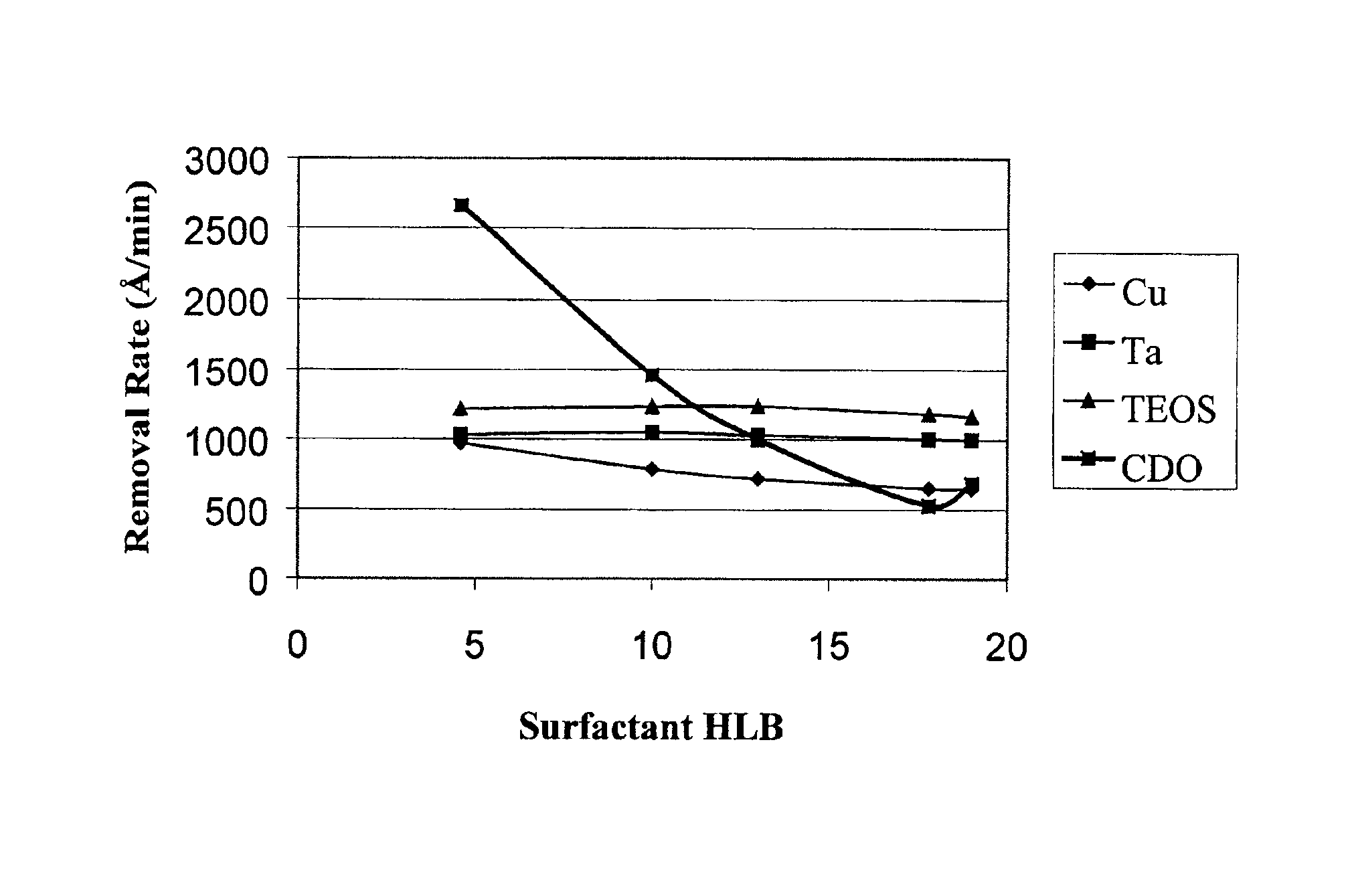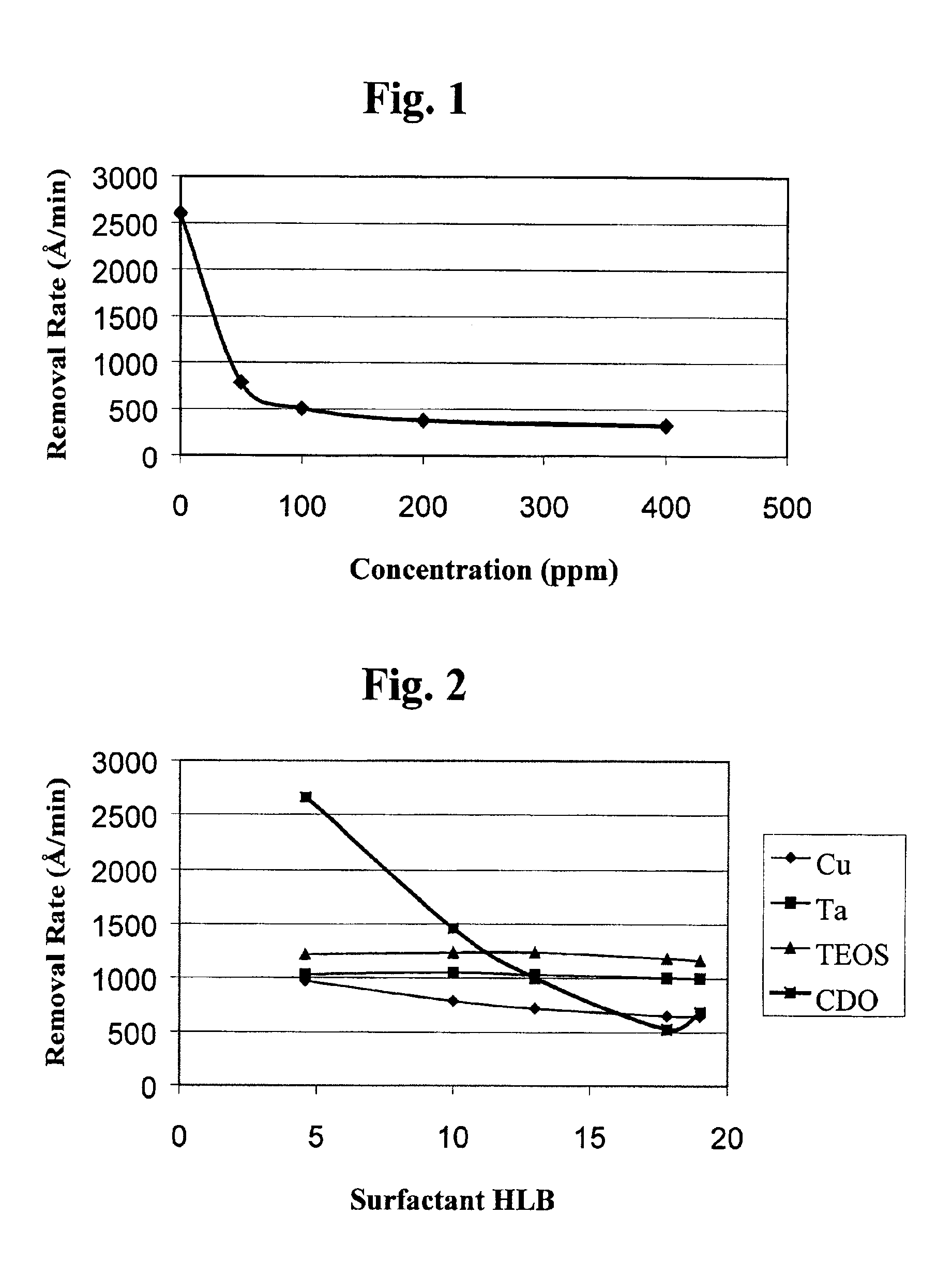CMP compositions for low-k dielectric materials
- Summary
- Abstract
- Description
- Claims
- Application Information
AI Technical Summary
Problems solved by technology
Method used
Image
Examples
example 1
[0036]This example illustrates the benefit of amphiphilic nonionic surfactants on the substrate removal selectivity of low-k dielectric constant material removal in comparison to the removal rates of copper, tantalum, and silicon dioxide materials.
[0037]Similar blanket wafer substrates containing tantalum (Ta), silicon dioxide (SiO2), or carbon-doped silicon dioxide (CDO) were polished with different polishing compositions (Polishing Compositions 1A-1I). Each polishing composition contained 7 wt. % colloidal silica (120 nm to 150 nm mean particle diameter), 0.02 wt. % benzotriazole, 0.30 wt. % acetic acid, 3 wt. % hydrogen peroxide, and various concentrations of different surfactants, and had a pH of about 8. Polishing Composition 1A (comparative) contained the anionic surfactant, ammonium polymethacrylate (Daxad® 32 surfactant, Hampshire Chemicals), at 1000 ppm concentration. Polishing Composition 1B (comparative) contained cationic polyethylenamine (Lupasol® SKA surfactant, BASF)....
example 2
[0041]This example illustrates the effect of amphiphilic nonionic surfactants on the substrate removal rate of a low-k dielectric constant material as a function of surfactant concentration.
[0042]Similar blanket wafer substrates containing tantalum (Ta), silicon dioxide (PETEOS), or Black Diamond® low-k dielectric (Applied Materials) materials were polished with different polishing compositions (Polishing Compositions 2A-2E). Polishing Composition 2A (control) contained 12 wt. % colloidal silica, 0.10 wt. % benzotriazole, 0.3 wt. % acetic acid, 3 wt. % hydrogen peroxide, and no surfactant at a pH of about 10 (adjusted with KOH). Polishing Compositions 2B-2E (invention) were the same as Polishing Composition 2A except that they contained 50, 100, 200, and 400 ppm polyoxyethylene(40)nonylphenyl ether (Igepal® CO-890 surfactant, Rhone-Poulenc), respectively. The removal rates (RR) of the tantalum, PETEOS, and low-k dielectric were determined for each of the polishing compositions. The ...
example 3
[0045]This example illustrates the effect of amphiphilic nonionic surfactants on the substrate removal rate of a low-k dielectric constant material as a function of surfactant HLB value.
[0046]Similar blanket wafer substrates containing tantalum (Ta), silicon dioxide (TEOS), or carbon-doped silicon dioxide (CDO) were polished with different polishing compositions (Polishing Compositions 3A-3E). Each of the polishing compositions contained 12 wt. % colloidal silica, 0.10 wt. % benzotriazole, 0.30 wt. % acetic acid, 3 wt. % hydrogen peroxide, and 200 ppm surfactant with a pH of about 10. Polishing Compositions 3A-3E (invention) contained polyoxyethylene(2)isooctylphenyl ether (Igepal® CO-210 surfactant, Rhone Poulenc) having an HLB of 4.6, polyoxyethylene(5)isooctylphenyl ether (Igepal® CO-520 surfactant, Rhone Poulenc) having an HLB of 10, polyoxyethylene(9)nonylphenyl ether (Igepal® CO-630 surfactant, Rhone Poulenc) having an HLB of 13, polyoxyethylene(40)nonylphenyl ether (Igepal® C...
PUM
 Login to View More
Login to View More Abstract
Description
Claims
Application Information
 Login to View More
Login to View More - R&D
- Intellectual Property
- Life Sciences
- Materials
- Tech Scout
- Unparalleled Data Quality
- Higher Quality Content
- 60% Fewer Hallucinations
Browse by: Latest US Patents, China's latest patents, Technical Efficacy Thesaurus, Application Domain, Technology Topic, Popular Technical Reports.
© 2025 PatSnap. All rights reserved.Legal|Privacy policy|Modern Slavery Act Transparency Statement|Sitemap|About US| Contact US: help@patsnap.com


